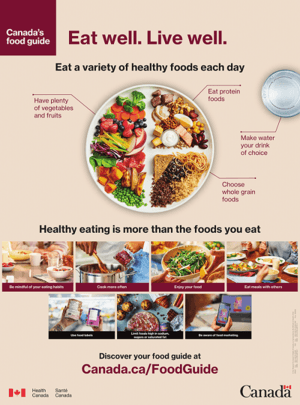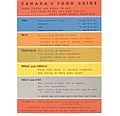Canada's Food Guide facts for kids
Canada's Food Guide (French: Guide alimentaire canadien) is a special guide from Health Canada. It helps people in Canada learn how to eat healthy. It's like a map for choosing good foods to keep you strong and well. In 2007, it was one of the most popular government guides requested by Canadians. Health Canada says these guides are tools to help everyone follow a healthy diet.
Contents
History
How it Started (1942)
Canada's first food guide came out in 1942. It was called the Official Food Rules. This guide helped Canadians eat well during World War II, when food was sometimes hard to find. It listed six main food groups: Milk; Fruit; Vegetables; Cereals and Breads; Meat, Fish, etc.; and Eggs.
Changes in 1944
In 1944, the guide was updated and renamed Canada's Food Rules. The Meat and Fish group grew to include cheese and eggs. Also, the guide suggested using iodized salt for the first time.
Updates in 1949
The guide was changed again in 1949. Teachers who used it in schools gave ideas for improvements. The five food groups stayed the same. The guide also started to recommend margarine made from vegetable oils. This was because of wartime shortages of animal fats. For the first time, Vitamin D supplements, like those from cod liver oil, were suggested.
New Name in 1961
In 1961, the guide got a new name: Canada's Food Guide. It used to be called "Rules." The guide still focused on eating whole grain foods. It also highlighted that pregnant and nursing mothers needed more milk. Citrus fruits were mentioned because they became easier to find in stores.
Four Food Groups in 1977
The guide changed from five to four food groups in 1977. "Fruits and vegetables" became one group. Daily potatoes were no longer a specific recommendation. This was also the first time the guide used the metric system. A helpful book called the Canada's Food Guide Handbook was also released.
Health Warnings in 1982
In 1982, the guide started to warn Canadians about how diet can affect heart health. A special report suggested that changes in the Canadian diet could help prevent heart problems.
The Rainbow Guide (1992)
In 1992, the guide was renamed Canada's Food Guide to Healthy Eating. It featured a colorful "rainbow graphic" instead of the old circle design. The four food groups got new names: Meat and Alternatives, Grain Products, Vegetables and Fruit, and Milk Products. A new section for "Other Foods" was added. This guide also changed its approach. Instead of just listing minimum food needs, it looked at a "total diet" for different ages, body sizes, and activity levels. It encouraged people to eat more grain products and less meat. For the first time, the guide was available online and in both English and French.
Eating Well (2007)
The year 2007 brought a new guide called Eating Well with Canada's Food Guide. A special guide was also made for First Nations, Inuit and Métis people. The main guide grew to six pages to include more information for Canada's diverse population. It also recognized that managing weight was important. The Milk Products group became "Milk and Alternatives" to include "fortified soy beverage" for those who don't drink milk. The guide also advised reducing trans fats and replacing saturated fats with unsaturated fats. Canadians over 50 were encouraged to take vitamin D dietary supplements. The guide also linked healthy food choices to reading food labels.
New Look in 2019
Canada's Food Guide was updated again in January 2019. This new guide focuses less on specific serving sizes. Instead, it recommends eating "plenty of vegetables and fruits, whole grain foods and protein foods." It also suggests choosing protein foods that come from plants more often. This guide was created using scientific reports on food and health, without influence from food companies.
Historical gallery
- Canada's Food Guide: A Pictorial History
Food Guide, 2019 Edition
Food Choices
The 2019 Guide suggests eating a variety of healthy foods every day. This includes lots of vegetables and fruits, protein foods, and whole grain foods. It also recommends choosing protein foods from plants more often. The guide advises limiting highly processed foods.
Drinks
The Guide recommends making water your main drink. Water has no calories, fat, or sugar, and it's very important for your body. You should drink more water when it's hot or when you are active. The Guide also suggests avoiding drinks with added sugar or fat. Drinks like coffee, tea, fruit juices, and energy drinks should be consumed in small amounts.
Healthy Habits
The Guide also shares tips for healthy eating behaviors:
- Be aware of your eating habits.
- Cook meals more often at home.
- Enjoy your food.
- Eat meals with family and friends.
- Use food labels to make good choices.
- Be aware of how food is marketed to you.
- Limit foods that are high in salt, sugar, or unhealthy fats.
- Get others involved in planning and making meals.
- Pay attention to when you feel hungry and when you feel full.
Serving Sizes vs. Proportions
In the past, Canada's Food Guide told you exactly how much of each food counted as one serving. It also suggested a specific number of servings from each food group. The 2019 guide changed this. Now, it shows a "proportional plate." This means your plate should be about 50% vegetables and fruits, 25% whole grain foods, and 25% protein foods. It focuses on the balance of your meal rather than counting exact servings.







